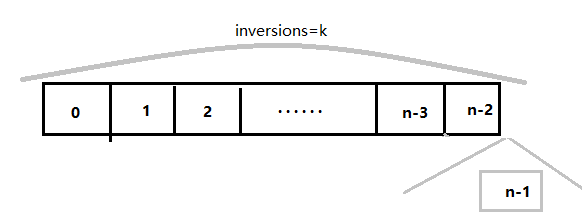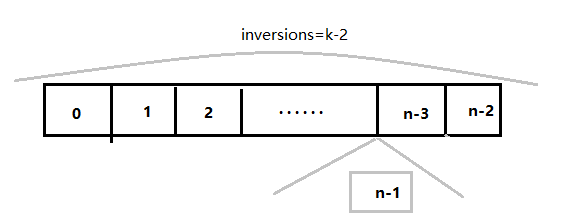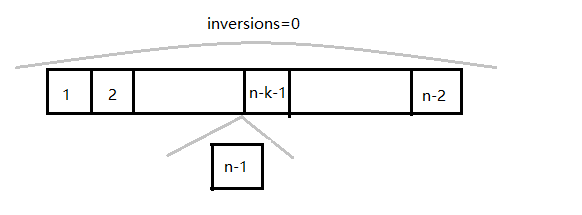Given an array, an inversion is defined as a pair a[i], a[j] such that a[i] > a[j] and i < j. We are given two numbers N and k, we need to tell how many permutation of first N number have exactly K inversion.
给定一个数组,inversion被定义为a [i],a [j],使得[i]> a [j]和i < j。 我们给出两个数字N和k,我们需要计算出 N 个数的排列有多少个正好是K个inversion。
例如:
输入 : N = 3, K = 1
输出 : 2
Explanation :
全部的可能情况:
123, 132, 213, 231, 312, 321
符合条件的情况 : 132 and 213输入 : N = 4, K = 2
输出 : 2
解法的伪代码如下:
If N is 0, Count(0, K) = 0
If K is 0, Count(N, 0) = 1 (Only sorted array)
In general case,
If we have N number and require K inversion,
Count(N, K) = Count(N - 1, K) +
Count(N – 1, K - 1) +
Count(N – 1, K – 2) +
.... +
Count(N – 1, 0)其解法思想如下:
如果我们有N个数并希望有K个inversion,并且假设(N-1)个数的所有inversion写在某个地方,那么新数(第N个数,即最大的数)需要被置于(N-1)个数的所有inversion中,在我们的答案中应该加上那些inversion计数变为K后的组合。
简单的说就是将第N个数插入在前N-1个数的所有组合中,将inversion=k的情况相加。
下面给出了各个情况的示意图:
1. 前n-1个已经组成了inversions=k,则第n个只需要插入在最后。

2. 前n-1个已经组成了inversions=k-1,则第n个需要往前插 1 位,让inversions=k。

3. 前n-1个已经组成了inversions=k-2,则第n个需要往前插 2 位,让inversions=k。

。
。
。
依次类推:

实现代码如下(c++):
// C++ program to find number of permutation with
// K inversion using Memoization
#include <bits/stdc++.h>
using namespace std;
// Limit on N and K
const int M = 100
// 2D array memo for stopping solving same problem
// again
int memo[M][M];
// method recursively calculates permutation with
// K inversion
int numberOfPermWithKInversion(int N, int K)
{
// base cases
if (N == 0)
return 0;
if (K == 0)
return 1;
// if already solved then return result directly
if (memo[N][K] != 0)
return memo[N][K];
// calling recursively all subproblem of
// permutation size N - 1
int sum = 0;
for (int i = 0; i <= K; i++)
{
// Call recursively only if total inversion
// to be made are less than size
if (i <= N - 1)
sum += numberOfPermWithKInversion(N-1, K-i);
}
// store result into memo
memo[N][K] = sum;
return sum;
}
// Driver code to test above methods
int main()
{
int N = 4;
int K = 2;
cout << numberOfPermWithKInversion(N, K);
return 0;
}Output:
5
























 252
252

 被折叠的 条评论
为什么被折叠?
被折叠的 条评论
为什么被折叠?








